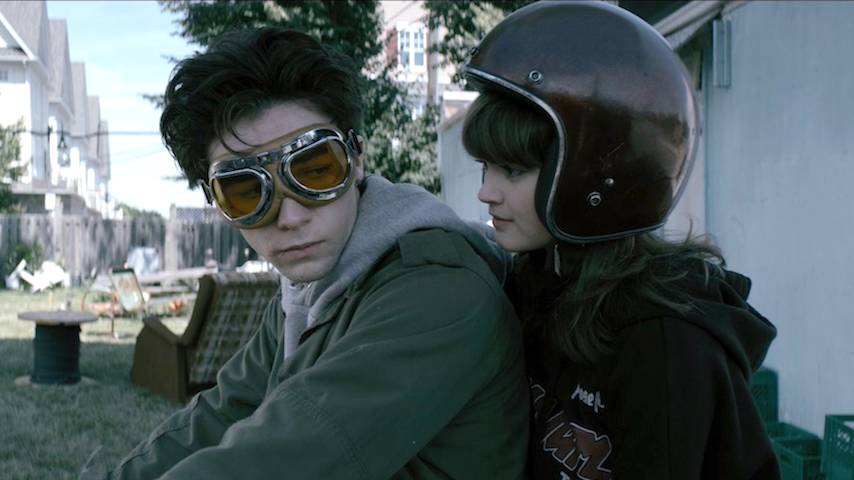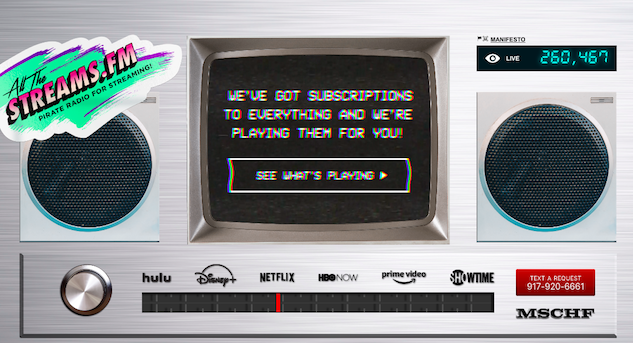7 Reasons Why 2020 Was the Year for Streaming TV

2020, it’s safe to say, has been a year.
I’ll leave it to greater minds to handle the more profound (read: grimmer) takes on that conclusion, but suffice it to say, the whole year-ness of 2020 so deeply pervaded the culture we consume, it hit the very foundations of how we consume culture in the first place.
Which is to say, regardless of how much it might have felt like the past few years were already defined by the rise of streaming, 2020 truly was the Year of Streaming. Between a global pandemic that trapped billions of people indoors for months on end, the launch of nearly half a dozen major new studio-centric streaming services, and the movie/theater/live music industries facing an upheaval so massive they had to evolve on an atomic level, the one constant has been the near-total ubiquity of streaming video on demand. There is literally no way to talk about culture in 2020—pop or otherwise—without talking about streaming.
So: Let’s talk about streaming. The ups. The downs. The quicks. The bites. Let’s hit all the trends that defined streaming this year, in the year that streaming defined.
![]()
1. Gotta Catch ‘Em All: The New Kids on the Block(+)

It’s basically a TV Twitter right of passage to joke about the looming rubicon across which the cost of keeping up with the Streaming Joneses will end up surpassing the cost of the premium cable fees those streaming subscriptions were meant to replace. Never has the punchline felt as precipitous, though, as it did this past year, which saw the launch of no fewer than five major new streaming services—Disney+ and Apple TV+ last November, Quibi in April, HBO Max in May, and Peacock in July.
Quibi didn’t make it through the year (RIP, LOL), but the other four, they’re straight up thriving. Honestly, if you love TV (which, hi) and have any interest in keeping up with the pop culture zeitgeist, 2020 has made it all but impossible for you to walk away without a subscription to all of them. HBO Max you need, obviously, because like it or not (I do not), that’s where all the cool kids are with the HBO catalogue, Adult Swim, Studio Ghibli, and originals like the buzzy Flight Attendant—and besides, starting at the end of the month, it’s where you’ll need to be to access half the blockbuster films you still can’t go to a theater to see. Disney+ you need because of Baby Yoda and his Space Dad, sure, but also because The Simpsons, Gravity Falls, Beyoncé, and Taylor Swift are there, and because you can bundle it with Hulu and ESPN+ (and, in international markets, Star+)—oh, and also because, starting next month, that’s where all that sweet, sweet new Marvel and Star Wars extended universe content will be. Apple TV+ you don’t really need yet, maybe, but if you buy any new Apple product, you get a year of it free, and do you know how many times you can rewatch Ted Lasso in a year? So many! Plus, Dickinson is cooler than enough people realize. As for Peacock, well, maybe its Originals line-up is still materializing (save for The Amber Ruffin Show and Saved by the Bell), but in the meantime, it’s got Parks and Rec and Columbo, and an ad-supported subscription tier that’s absolutely free. (Though be warned, if you’re using Peacock to access The Office, they’ve put Seasons 3-9 behind the subscription paywall. I told you—can’t leave 2020 without all four!)
Niche streamers, in the meantime, aren’t getting any thinner on the ground—every service on our Streaming Subscription Guide bulked up their libraries in 2020, IMDb TV even going so far as to start distributing, with Anthony Horowitz’s slick teen spy series Alex Rider, scripted originals of its own. (A reboot of Leverage is due later in 2021.) January, meanwhile, is set to bring us discovery+, a reality-focused streamer from Discovery that is launching with the largest extant library of any streamer to date, and exclusive access to the entire Planet Earth series.
Sorry, cable—we really should have appreciated you more even after you were the only (expensive) game in town.
2. Second Chances: Weirdos Movin’ on Up (or at Least, Over)

When it was still unclear who might come out on top of the streaming wars (well, who might be able to come out on top, behind Netflix), both Facebook and YouTube made serious moves to compete. As two of the world’s richest tech companies, it wasn’t unreasonable to imagine they might have a chance—Amazon’s Prime Video was carving out a solid enough niche for itself, and it didn’t have either YouTube’s streaming infrastructure or Facebook’s social networking framework behind it. With Facebook Watch bringing in talent like Catherine Zeta-Jones (Queen America), Elizabeth Olsen (Sorry for Your Loss) and the creator of SKAM (Gen Z’s favorite series for five years running), and YouTube Premium giving free rein to creators with just killer vision—Liza Koshy, Shawn Simmons, Lauren LeFranc—“not unreasonable” rapidly got upgraded to “genuinely possible.” Shortly thereafter, DC Comics came in with its own proprietary streamer, DC Universe, and got to work making cool, weird shows that DC’s broadcast home, the CW, would never in a million years dream of giving series pick-ups to.
And then, they all chickened out. Through some combination of low viewership numbers (which the public will never be made privy to) and poor platform synergy (turns out few people understand how to access Facebook Watch, and ever fewer people who already have more free YouTube to watch than they could get to in a thousand lifetimes end up all that interested in paying to watch the kinds of high-budget scripted content they’ve turned on YouTube to avoid?), neither Facebook Watch nor YouTube Premium ended up being the fertile home for original scripted streaming content that either platform had been hoping for. DC Universe might have done better, but with its parent company, WarnerMedia, getting ready to launch HBO Max, keeping the DCU platform running was a losing proposition. Which means, all those really great shows? The ones that got greenlit in a streaming bubble when more mainstream platforms might not have given them the chance? They were clean out of luck.
Clean out of luck, that is, until this year when all of a sudden a ton of these weirdo orphaned scripted series were getting licensed to new streaming homes—some, even, with official promises of renewal. From Facebook Watch, Sacred Lies and Limetown headed over to Peacock. From YouTube Premium, Cobra Kai headed to Netflix and Step Up: High Water headed to STARZ (both with renewals), Dallas & Robo headed to SYFY’s new late-night animation block, TZGZ, and Wayne headed to Prime. In a slightly more lateral move, meanwhile, DC Universe sent Stargirl (renewed) and Swamp Thing (not) to the CW, and Harley Quinn and Doom Patrol (renewed, both) to HBO Max.
As sad as it still is to lose some of the biggest scripted swings these nascent platforms took—YouTube Premium’s Impulse and Ryan Hansen Solves Crimes on Television are particularly tough losses, as is Facebook Watch’s SKAM Austin—seeing cross-platform pick-ups become more than just the rare exception to an unspoken streaming rule is heartening, especially for the weirdo series that will always have audiences, if streamers (or analog networks!) are willing to go out and find them.
And look—it’s a pattern that’s already paying dividends: In 2022, Natasha Allegri’s weirdly wonderful Bee and Puppycat will return for a second season on Netflix, where it’s moving over from its original home on Cartoon Hangover/VRV. How long it might stay there, once Netflix gets its subscription-first algorithm’s claws into, is anyone’s guess. But for now, long live the weirdos!
3. Pivot to Reality

Before Disney, Apple, WarnerMedia and NBCUniversal made their various bids for Netflix’s streaming crown (or, at the very least, for Prime’s or Hulu’s), both YouTube and Facebook made attempts of their own—YouTube Premium and Facebook Watch. The original series to come out of each of these attempts were, for the most part, great (see the “Weirdos” section above for more), but neither platform was ever really built to thrive in the scripted content game.
It made sense, then, that 2020 saw the streaming arms of both sites pivot hard into the kind of reality-first programming that their respective user bases were already logging on to see—think documentaries (Ball in the Family and Humans of New York on Facebook Watch; RESIST and The Age of A.I. on YouTube Premium), celeb-hosted talk/reality shows (Red Table Talk and Steve on Watch on Facebook Watch; Kevin Hart: What the Fit and David Blaine Ascension on YouTube Premium) and gimmicky competition series (Returning the Favor on Facebook Watch; Sleeping with Friends on YouTube Premium). That said, despite both swimming around in the reality pond, there’s less overlap between the Watch and Premium brands than you might expect. In general, Facebook Watch is home to a lot of celebrity-hosted content—Taraji P. Henson, Marshawn Lynch, Huda Kattan, Courtney Cox, Shaq, and Justin Bieber all have shows that do major numbers, while the Jada Pinkett Smith-hosted Red Table Talk brand has spun off both a related Will Smith series (Bucket List) and a Red Table Talk mini-series featuring the Estefans. YouTube Premium, meanwhile, has made a point this year of meeting the pandemic moment as a social hub for its socially distanced global audience, hosting first a blockbuster virtual commencement for the Class of 2020, then a virtual HBCU Homecoming, and finally (and most recently), The Great Gift Exchange, a winter holiday extravaganza hosted by a world-famous gift-wrap artist (apparently a thing) that doubles as a fundraiser for a series of charities chosen by the participating creators. YouTube has also gone harder into the musical side of things—unsurprising, given its position as the go-to site for music videos—featuring docuseries on everything from KCON to YUNGBLUD to the whole history of Coachella.
Given how popular reality-first networks like Bravo, E! and MTV are, it was only a matter of time before some streaming platform figured out that was a niche waiting to be filled—that Facebook and YouTube, two streaming services built around social networks where the messy lives of real people are a major draw, got there first? That makes all the sense in the world. Their joint pivot deeper into reality in 2020 also presages the arrival of discovery+, which is set to launch in January, and promise to not only comprise exclusive content from HGTV, Food Network and TLC personalities (a preview of Chip and Joanna Gaines’ new content network included), but also a vast-ranging library of true crime, general docuseries and nature programming, besides. Up against what the nascent service is touting as the “largest-ever content library for a new streaming service” to launch with (55k+ individual episodes from Discovery’s whole family of brands), neither Facebook Watch nor YouTube Premium will have a chance to become the Netflix of reality-first programming. But as tangible proof of the kind of streaming’s capacity for more than just bingeable scripted content, they could have done worse.
4. The Foreign Language Explosion: I Am Eating Bread and Crying on the Floor

“I am eating bread and crying on the floor” was voted the “Most 2020 Duolingo Phrase” by Duolingo users. Shows like Viki’s The Goddess of Revenge (Korean), Topic’s Vernon Subutex (French), and Netflix’s Babylon Berlin (German), Élite (Spanish, shown above) and Aggretsuko (Japanese) were just some of the foreign language series helping Duolingo’s users learn (and cry) their way through the year.
In its first ever ”Year in Language” Global Report, language learning app Duolingo makes a convincing anecdotal case for the influence that foreign language streaming content might have had on its globally homebound 2020 user base. Pointing to the 30 million new users that signed up for Duolingo in the weeks immediately following the World Health Organization’s pandemic announcement alone (a 67% increase over the same period in 2019, in trends reflected across the industry worldwide), the report suggests that just as billions of people around the world were finding themselves with more time than ever to stay home and binge whatever their streamer of choice had to offer, a significant percentage of those billions were coincidentally inspired to pick up a new language.
The validity of this suggestions seems to be born out by the top-line item in Netflix’s own “What We Watched 2020” report, which notes that, at least in the U.S., viewership numbers for foreign language titles increased over 50% in 2020 (compared to the same Jan-Nov period in 2019), with the numbers for anime more than doubling, and those for K-Dramas nearly tripling. Global trends, meanwhile, also squared up, non-English Netflix Originals like Money Heist (Spanish), #Alive (Korean) and Ragnarok (Norwegian) hitting end-of-the-year Top 10s in almost 100 countries at the same time as Duolingo’s list of second-most-popular languages—a category which reads, at least to this writer, as the languages people were more likely to be picking up for fun, non-academic reasons—absolutely exploded (16 discrete languages hitting the second-most-popular mark in 2020, compared to just 9 in 2016).
Netflix isn’t the only streaming platform to have made an effort to bolster its foreign language brand in 2020, either. Anglo-centric streamers like Acorn TV and Sundance NOW have spent the year adding blockbuster foreign language titles like Wisting (Norwegian), The Bureau (French), Deutschland 89 (German) and Rebecca Martinson (Swedish) to their ranks, while even smaller platforms like Kanopy Kids, Tubi and artsy newbie Topic have stocked their digital shelves with offerings from even further afield (Brazil, Russia, Senegal). Similarly, at the same time as Hindi, Korean, Japanese, Turkish and Chinese have taken the lead as Duolingo’s five fastest growing languages, streaming interest in Asian television (and film!) has exploded across the board: for Netflix, just see above, but also note Sony’s recent acquisition of anime-centric streamer Crunchyroll for $1.175 billion, and the vibrant global fan community over at Asian drama hub Viki, where passionate K-, J-, C- and T-drama fans regularly gather to “break down language barriers” by crowdsourcing subtitles for the streamer’s entire library of Korean, Japanese, Chinese and Taiwanese content, a project that covers more than 200 languages. Further proof this is a trend that transcends borders: per The Economic Times, K-dramas have seen aggressive growth in India during the pandemic, viewership numbers on Viki increasing 46% between March and September at the same time as the number of India-based Korean language learners spiked 256% on Duolingo. 256%!
All this isn’t to say that foreign language television hadn’t been available before 2020—Netflix has been developing non-English Originals nearly as long as it’s been in the Originals game, and Crunchyroll existed years before that—but 2020 still felt like something of a watershed. Not only has the rise of streaming made foreign language series more accessible to average TV audiences the world over than they’ve been in the history of the medium, the ubiquity of foreign titles across streaming platforms—in the middle of a global pandemic, in the middle of a language learning app boom—has made them popular. No more are subtitles necessarily barriers to a series’ entry into the zeitgeist; these days, a Spanish-language teen thriller like Élite is just as likely to become a part of the pop culture conversation as is something as thoroughly Hollywood as Riverdale, while hyper-fervent fandoms are just as likely to form around K-dramas like The King: Eternal Monarch and Goblin (Guardian: The Lonely and Great God) as they are around English-language favorites like Anne with an E or Lucifer. Incredible.
5. Chaos on the Fringe: Allthestreams.fm

Way back in March, literally days before the NBA became the first American institution to make the pandemic real by shutting its season fully down, internet chaos machine MSCHF dropped its most ambitiously mundane project to date: allthestreams.fm. A pirated livestream of six subscription streaming services—Hulu, Disney+, Netflix, HBO Now, Prime Video and (for some reason) Showtime—broadcast to a single skeuomorphic “TV” screen from a handful of VPN-shielded computers and airing literally whatever struck each account owner’s fancy at any given moment in time—Daria, Keeping Up With the Kardashians, The Mandalorian, Monk—allthestreams.fm represents a 2020 streaming trend mostly insofar as it touched upon a core truth that binged-out streaming audiences would start realizing more and more as the year went on: Sometimes, you just want someone else to decide what’s on your TV.
As Paste’s very own TV Editor Allison Keene noted late last month when reviewing Netflix’s recently introduced “Play Something” button, as rewarding as it can be to sit down and consciously consume really excellent content you’ve explicitly chosen to watch, all that curation can be exhausting. Sometimes, you don’t want to curate. Sometimes, “it’s [just] nice to not be in total control, to see a sea of content and—instead of diving in to a specific point—just float languidly in the surf.” In a blog on Medium a few weeks later, culture writer Carvell Wallace made much the same point, meditating on the beauty in live television to let you just… not choose. “It gets exhausting choosing one thing from among all the things there are,” he writes. “It’s just nice to sometimes take a break. It’s just sometimes nice to only be responsible for a simple binary choice: stay or go?”
Daria or Aladdin? On or off? Streaming, as a whole, still hasn’t come up with a way to let us so cleanly not choose (sorry, “Play Something” button), but for two beautiful days, back in what already feels like the Before Times, that’s exactly what allthestreams.fm gave us, and it was beautiful.
6. Harsh Truths: Fans Need Not Apply
For all that it really was heartening to see so many worthwhile streaming shows get a shot at finding new life on other streamers (or even on regular old terrestrial TV) in 2020, this year also walloped us with a tidal wave of surprise cancellations/unrenewals. While many of those decisions flowed directly from the ongoing pandemic—the unrenewals of enormous ensemble series like The Society and GLOW, especially—they nevertheless all end up feeding into a pattern that’s been building steam for years: Streaming is making television shorter.
I’m not talking in terms of episode length (unfortunately, though there has been some improvement on that front in recent years), but in terms of how many episodes any given show will ultimately be given to tell its story. Gone are the 22-episode seasons enjoyed by broadcast procedurals and sitcoms alike throughout the last many decades. Gone, too, are the 5-, 6-, 7-, 15-season series runs that gave tentpole series like The Office, Supernatural and Grey’s Anatomy the runway to both set up slow-burn arcs with big long-run pay-offs, and to be weird just because they could. Hate to say it, but on a streaming platform, the return on investment for extended series runs just isn’t there even in the best of times—and 2020, sorry to break it to any reader who’s been living under a COVID-free rock, hasn’t been the best of times.
The Ringer’s Alison Herman went into deeper detail on this trend earlier this year (and Business Insider has the numbers), but the long and short of it is: With the subscription streaming model incentivizing the accrual of new subscribers over the maintenance of existing ones, there’s little value in renewing most series for more than two or three seasons, regardless of how passionate a show’s fans are, or how glowing its critical reception. A fourth season of Anne with an E, no matter how ecstatic it would make that show’s existing fanbase (and this magazine’s TV editor), could hardly be expected to bring in enough new subscriptions to justify the cost of production. A brand new teen series, though—maybe one from Mindy Kaling, featuring an unknown comedic wunderkind as its lead—now that just might.
Whether or not Netflix’s statistical preference to cancel its original scripted series after two or three seasons will hold when it comes to 2020’s new major players, it’s hard to say—Disney+ has such an ambitious slate in place, between Marvel and Star Wars, that it will be ages before we’ll get enough data to know what their longterm plans are with any of them, while Peacock and HBO Max each have enough exclusive content from their respective studio vaults (not to mention HBO Max’s 2021 movie release plans) that it’s unlikely either of their new subscriber numbers will be guided by original scripted content anytime soon. Apple TV+ is new enough to the content scene on all fronts, meanwhile, that it will want to spend a long time building a foundation before it starts making the kinds of decisions that might be called “a pattern.” As a massive fan of High School Musical: The Musical: The Series, Saved by the Bell *and* Ted Lasso, the likelihood that Disney+, Peacock and Apple TV+ will end up giving fans plenty of each is exciting, but it’s not set in stone—as exceptional as each is, that doesn’t change the fact that the streaming subscription model just doesn’t incentivize anything but churn.
7. A Cautionary Tale: The Rise and Fall of Quibi

On the one hand, the less said about Quibi, the better. A nearly $2 billion boondoggle that lasted literally half as long as I, personally, owned the domain whatisquibi.com (this is one thousand percent true), Quibi was, , a bafflingly out-of-touch solution to a problem no one had. “Quick bite” videos, optimized for mobile-first consumption, surrounded top to bottom with ads? Genuinely nothing could have made it clearer that Quibi masterminds Jeffrey Katzenberg and Meg Whitman weren’t hanging around YouTube in the 2010s than their full-throated insistence that they were pioneering a narrative art form Nothing Much to Do, Carmilla and The Lizzie Bennet Diaries had perfected more than half a dozen years ago. More insulting still? The sheer lucre involved in the venture—$1.75 billion raised by the end of its second round of investment funding (“roughly the same as the gross domestic product of Belize, give or take $100 million,” TechCrunch). After years of watching venture capitalism just gut independent and local journalism, to see that much cash just…disappear…into the black hole of such an inherently flawed nü-media scheme? Deeply frustrating.
On the other hand, in a year that was shaped by disaster piled on top of disaster, watching Quibi trip over its own golden-armed hubris and just absolutely eat it was objectively—and believe that I’m saying this with my whole chest—hilarious. Every day that ended up being a Quibi day made being Terminally Online in 2020 bearable, just really fun jokes coming in hot and fast. So, okay, here at the end of the year, let’s give Quibi its streaming due—
Quibi is dead. Short live Quibi.
Alexis Gunderson is a TV critic and audiobibliophile. She can be found @AlexisKG.
For all the latest TV news, reviews, lists and features, follow @Paste_TV.








































